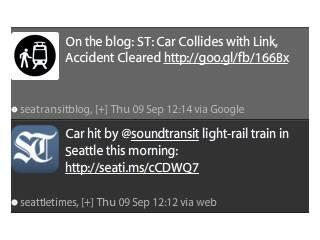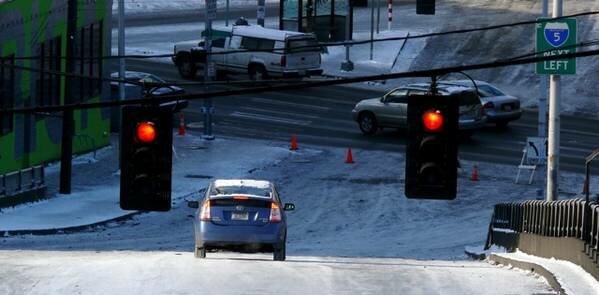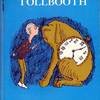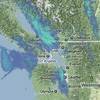And now a video preview of what you're likely to see tonight, once the roads ice back up. People, charge your cameras! If you're driving, a safety tip: Avoid really steep hills.
...
 The "he said/she said" in my Twitter feed
The "he said/she said" in my Twitter feed
The Seattle Times has a habit of reporting on accidents involving the light rail thusly: "Car hit by light-rail train in Seattle." (For more instances, go here.)
In reading the story, you learn that the car "attempted to make a turn onto Othello Street against the light" and collided with the train. Seattle Transit Blog writes it up that way: "Car Collides with Link."
For contrast, try to imagine if the Times reported on car accidents in ways that gave no indication who caused the accident: "Car hit by other car in Seattle this morning." Doesn't seem newsworthy does it?
But in the Times headlines, light rail is always implicitly the agent of destruction: light rail "injures two" (who tried to make an illegal left turn in front of a sign marked No Left Turn), a woman "sustain[ed] injury" when she ran into the light rail, and a girl talking on her cellphone who stepped into the trackway was "struck by light-rail train." In none of these cases did the illegality, incompetence, or obliviousness of the person who caused the accident make it into the headline.
"Light-rail train hits pickup"--making an illegal turn, as it happens. From the Times headline (not even in the passive voice this time), you'd have to assume the light rail was at fault. Otherwise you might have read an investigative story about how Seattle drivers' illegal left turns are costing a cash-strapped Sound Transit a bundle further damaging light rail's reputation for reliability.
 Icy overpass. Closed street blocked by cones. Busy traffic at bottom of hill. A driver decides safety is for other people.
Icy overpass. Closed street blocked by cones. Busy traffic at bottom of hill. A driver decides safety is for other people.
Here is a story from yesterday afternoon: "The mother and children were walking across a controlled crosswalk with flashing lights and bright yellow crossing signs when a vehicle driven by a 31-year-old woman hit the children."
Earlier that day, Wednesday, August 4, Dan Bertolet wrote a post called "Car Hater," in which he referenced the fact that the leading cause of death among children in the U.S. is motor vehicle injuries. Sightline picked up the mini-meme, noting that car accidents are the leading cause of death for anyone under 35.
The point in both cases was for people to reassess their driving habit in light of the inevitable danger involved in piloting a multi-ton vehicle at speed. The safest way to drive is not to drive at all, but no one thinks, on an impulse jaunt to the store, that they've just upped the chances they'll kill someone.
We see people every day--if we're honest, we are those people--who believe in their heart that statistics are for people who don't drive as well as we do. It's easy enough. You assume the brakes will work, the pedestrian won't trip, the light will stay yellow long enough. It's a tragedy of the driving commons.
In 2009, over 6,000 lives were spared when the recession cut down on car trips. Think of that: 6,000 people alive today because someone thought twice about needing to drive somewhere.







Most Recent Comments